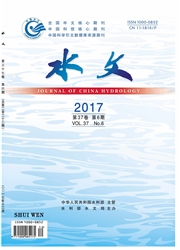

 中文摘要:
中文摘要:
为揭示碳酸盐岩风化对河流流域化学风化过程及碳汇效应的影响,以流经我国亚热带地区的典型河流——西江为对象流域,在2011年4月~2012年3月对西江阳朔、昭平、梧州三个干流断面每月定期和暴雨期加密分析河水水样。研究结果表明:(1)三个断面都属于偏碱性水质,水化学类型为HCO3—Ca型,电导率沿西江干流逐渐升高,这主要是体现了流域内广泛分布的碳酸盐岩对河水水化学特征的控制作用。(2)在一个完整的水文年中,通过对三个干流断面逐月计算得出西江河口梧州断面碳通量总通量为51.03×108kg CO2/a,昭平段和阳朔段分别为1.55×108kg CO2/a和1.80×108kg CO2/a;碳通量强度分别为15 606.13kg CO2/km2/a、10 373.61kg CO2/km2/a、32 223.08kg CO2/km2/a。(3)流量为岩溶碳通量的主控因子,降雨影响流量,进而影响碳汇效应的这种现象可能会受到人为作用的干扰。三个干流水体HCO3-浓度的变化趋势各有不同,这可能是因为HCO3-浓度与碳通量的关系比较复杂,涉及到不同的反应机理。三个断面的p H值和温度与碳通量没有明显的相关性,这可能是由于生物的"生物泵"作用主要是日变化为主,月尺度的p H和水温变化并不能真正反映p H和温度对碳通量的影响。
 英文摘要:
英文摘要:
To reveal the effects of carbonate weathering on chemical weathering processes and its carbon sink effect in river catch- ment, this paper took the Xijiang River in Guangxi as the research object, which is a typical river that flows through subtropical areas in China. The river water samples were collected from three mainstream sections: Yasngshuo, Zhaoping and Wuzhou, which were analyzed regular monthly and intensive observation during heavy rainfall period from April 2011 to March 2012. The research shows the results as follows: (1) The water of the three mainstream sections is alkali waste water and its hydrochemistry type be- longs to HCO3--Ca. EC (electric conductivity) increases gradually along the mainstream, this phenomenon primarily embodies the control effect to chemical characteristics by carbonate rock that is widespread in river catchment; (2) In a whole hydrological year, the total flux of carbon at three mainstream sections were calculated month by month, and 5.10×1012kgCO2/a at the Wuzhou sec- tion, 1.55×1012kgCO2/a and 1.80×1012kgCO2/a at the Zhaoping section and Yangshuo section respectively. The intensity of carbon flux is 15 606.13kgCO2/km2/a, 10 373.61kgCO2/km2/a and 32 223.08 kgCO2/km2/a respectively; (3) The flow is the primary factor of karst carbon flux, the phenomenon that rainfall influences flow, further influence the effect of carbon sink, it may be affected by human activity. The change trend of HCO3- concentrations is different in the water at the three mainstream sections, the possible reason is that the relationship between the HCO3- concentrations and carbon flux is complex, and it relates various reaction mecha- nisms. The carbon flux has no obvious correlation with pH value and temperature, it may be caused by the effects that the biolog- ical pump is mainly diurnal variation, pH value and hydrological changes can not truly reflect the influence on the carbon sink by pH value and temperature in monthly scale.
 同期刊论文项目
同期刊论文项目
 同项目期刊论文
同项目期刊论文
 期刊信息
期刊信息
